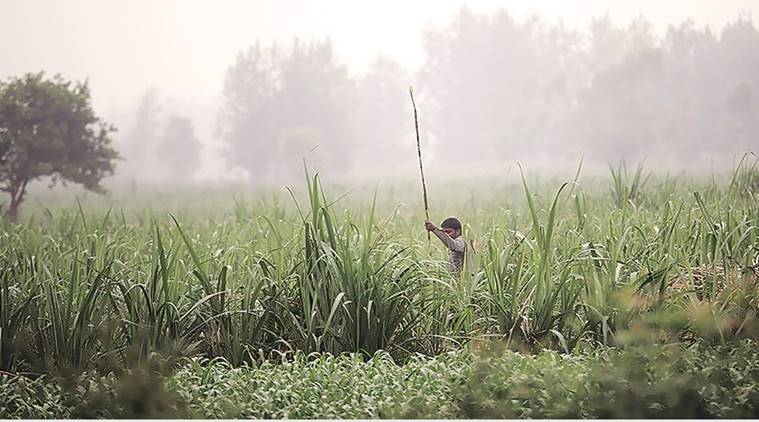 All costs considered, cane cultivation promises a net return of Rs 7,500 per bigha, which is 62.5% more than the production cost. (Praveen Khanna)
All costs considered, cane cultivation promises a net return of Rs 7,500 per bigha, which is 62.5% more than the production cost. (Praveen Khanna)
Why are farmers growing sugarcane, even as arrears payable to them by mills in the current 2017-18 season has crossed Rs 23,000 crore? The answer is simple: It is one of the few crops today that’s still profitable to grow. The Indian Express spoke to a cross-section of farmers in Shamli district of western Uttar Pradesh (UP), to get a reasonable idea of what it costs to cultivate sugarcane on one bigha and the corresponding returns based on the price and yield of the crop from that area (5.9 bigha make an acre).
The seed requirement for cane is generally pegged at 5 quintals per bigha. At the UP government’s current state advised price (SAP) of Rs 325/quintal, the cost of the crop planted as seed comes to Rs 1,625. Field preparation and sowing expenses are around Rs 700 per bigha each. Spending on nirai and gudai (weeding and hoeing) is another Rs 1,500 per bigha.
Coming to fertilisers, farmers typically apply 15 kg of di-ammonium phosphate (costing Rs 350), 50 kg urea (Rs 327), 10 kg muriate of potash (Rs 120), one kg sulphur (Rs 100), one kg zinc (Rs 100) and 2 kg Zyme (a plant growth regulator; Rs 100) per bigha. Crop protection chemical costs are even more: Rs 720 for 60 ml of Coragen (used against early shoot borer and top borer insect pests), Rs 250 for 20 mg of Dantotsu (to control white grub and termites), Rs 300 for 6g of Sempra (a weedicide), Rs 100 for 200g of Bavistin (a fungicide) and Rs 50 for 6g of Strepto-Plus (an anti-bacterial).
Nutrients and chemicals together, thus, add up to over Rs 2,500 per bigha. The next item is water. Farmers give 15 irrigations on an average for sugarcane, costing Rs 50 each or Rs 750 per bigha (this is using electricity; pumping with diesel gen-sets will be five times more expensive). They also spend about Rs 1,000 on bandhai or tying and propping up the cane plants to prevent lodging after they have grown beyond five feet (this is done 3-4 times, each costing Rs 300-350).
Finally, there is harvesting and transport. Labourers now charge Rs 40 or so for harvesting every quintal of cane, while loading and transport to the nearest purchase centre cost an additional Rs 10 per quintal. The average yield per bigha in Shamli is 50 quintals for CoJ-67, an old “general” variety, and 60 quintals for Co-0238, an “early-maturing” cane that has gained popularity in the last 3-4 years.
All in all, the cultivation cost of sugarcane on a bigha yielding 60 quintals works out to roughly Rs 11,800 (say, Rs 12,000). On the other hand, the realisation from this crop, at the SAP of Rs 325/quintal for early varieties, would be Rs 19,500. It translates into a net return of Rs 7,500 per bigha, which is 62.5 per cent more than the production cost.
“We will not get this from any other crop. In basmati paddy or potato, there’s too much of price uncertainty, while the government hardly procures any wheat here. Moreover, the agola (green top leaves) from sugarcane takes care of the fodder needs of our animals during the crushing season from November to April,” says Ashok Malik, who farms cane on 20 out of his 30-bigha holding in Karoda Hathi village in Shamli tehsil.
But there is a catch. The above costs don’t take into account interest on working capital, which would be even more in a scenario of delayed payments. Factories are supposed to pay farmers the SAP on cane within 14 days of purchase, but Malik hasn’t received money for even half of the 1,200 quintals he has supplied to the Upper Doab Sugar Mill in Shamli this season.
“Further, it’s not just what we spend from our pockets. There is also the imputed value of family labour, rent on owned land and interest on our capital assets. The Swaminathan Committee had recommended 50 per cent return after factoring in all these costs. After all, don’t we have other expenses as well, including on quality education for our children and healthcare?,” points out Jitender Hooda, a farmer from Shamli’s Kheri Bairagi village, who cultivates sugarcane on 40 out of his 48-bigha land.